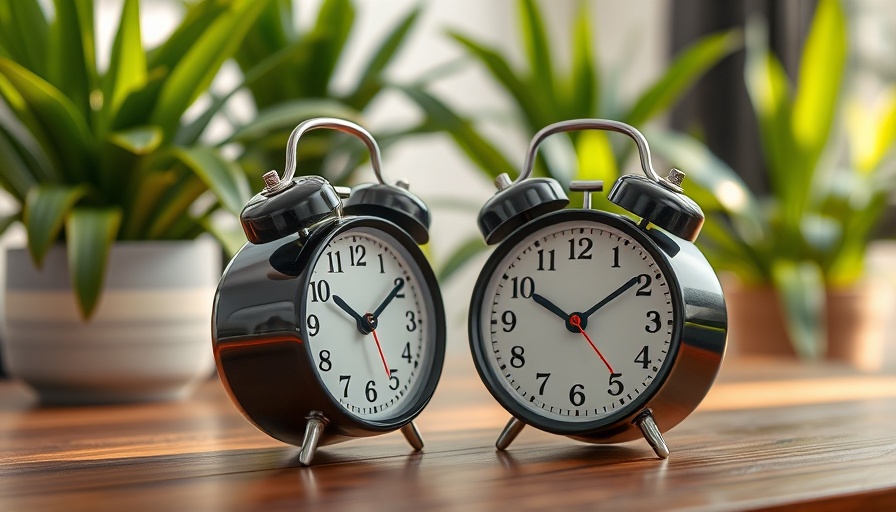
Understanding the Daylight Saving Time Debate
As we gear up for another biannual clock change, the debate surrounding Daylight Saving Time (DST) intensifies. In spring, we lose an hour of sleep as we spring forward, while in fall, we gain that hour back, leading many to wonder if this age-old practice still serves us. Popping up at discussions throughout neighborhoods, coffee shops, and online forums, the conversation often teeters between the benefits of permanent DST versus standard time.
The Historical Roots of Daylight Saving Time
Daylight Saving Time dates back to World War I, when Germany first implemented the practice to save energy. The idea was soon adopted by other countries, including the U.S., aiming to reduce the reliance on artificial lighting. As Benjamin Franklin's original suggestion in a 1784 essay reminds us, more sunlight leads to less candle usage—a quaint notion in today's technology-driven society.
Despite its historical roots, the feasibility of maintaining DST has been questioned in modern times. With changing lifestyles and technological advancements, the perceived benefits of energy conservation may not hold water anymore. As more states debate ditching the time switch, many wonder what a world without clock changes would look like.
The Case Against Time Changes: Health and Wellness Concerns
Health experts argue that the elimination of seasonal clock changes could lead to significant benefits. A single hour shift in our schedules can wreak havoc on our circadian rhythms, leading to sleep disturbances. Additionally, studies have shown that heart attacks spike by 24% in the week following the spring forward. Similarly, sleep deprivation has detrimental effects on our productivity and can increase accidents—both on the road and at the workplace. During the Monday immediately after time alterations, for example, major financial markets have exhibited negative trends.
Moreover, environmental advocates suggest that stopping the clock changes can even encourage a healthier planet. An increase in sleep quality among the population could lead to a reduced demand on healthcare systems, which further diminishes pollution outputs during energy consumption.
The Ecological Impacts of Time Changes
The repercussions of DST extend beyond human health. Rob Boyle, the founder of Emission Index, warns that shifting our clocks interferes with wildlife. Animals thrive on predictability in their day cycles for feeding and breeding. When humans disrupt these patterns, it can have a cascading effect on entire ecosystems, highlighting how interconnected our lives are with nature's rhythms.
Staying Forward vs. Falling Back: What Does the Public Prefer?
Public sentiment seems to lean towards abolishing the time switch altogether. Surveys indicate that a mere 19% of people want to keep the practice. The real contention lies in whether we should adopt a permanent standard time or daylight saving time. Advocates for the latter argue the benefits of enjoying extended daylight hours in the evenings, potentially enhancing outdoor activities and leisure time after work—a key consideration for families and those focused on work-life balance.
How This Could Change Your Life: Practical Insights
As a homeowner interested in DIY projects and the community’s well-being, understanding the implications of this debate is key. Imagine weekends filled with more daylight for gardening, renovations, and family activities! Should we cast a permanent shadow over sporadic time changes, every season may feel like a breath of fresh air, inviting more quality time spent outdoors.
Additionally, with increased awareness about health consequences, individuals can proactively optimize their routines. From sleep strategies to outdoor plans, residents could thrive in a community that embraces stability in their schedules.
Future Predictions: What Lies Ahead?
The future of Daylight Saving Time remains uncertain, but with the combined discussions from legislators and the public, it’s clear the landscape is changing. Whether we’ll remain set to standard or daylight time is still up for debate, but rest assured, many stakeholders are looking for solutions that prioritize health, community, and sustainability.
The rising discontent with time changes might usher in a new era where people can enjoy longer days without the hassle of shifting gears twice a year. As we stand at this crossroads, engagement in these discussions ensures our future is shaped by collective decisions that benefit everyone.
Ultimately, as homeowners consider whether or not to support one side of the debate, understanding the nuances will be vital in making informed choices.
If you’re passionate about improving your lifestyle and advocating for a better community, get involved in local conversations about this topic. Keep abreast of potential legislation that could come your way, and voice your opinion on the future of timekeeping. Every small action counts towards creating a more harmonious rhythm in our lives.
 Add Row
Add Row  Add
Add 




Write A Comment